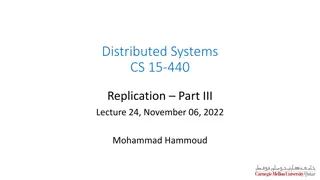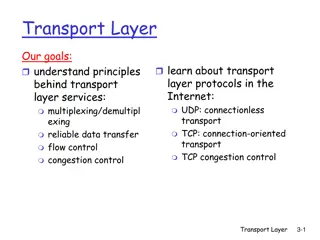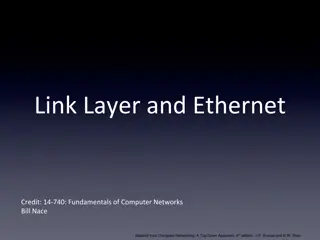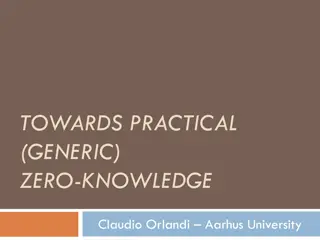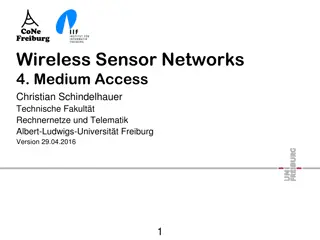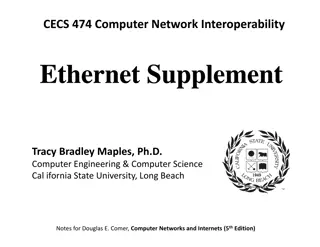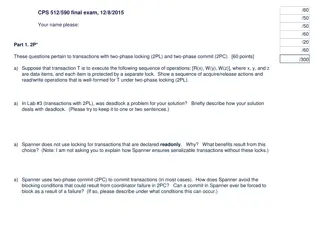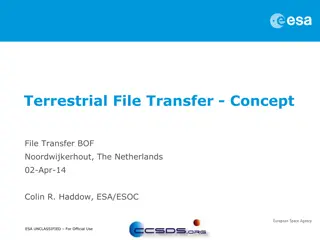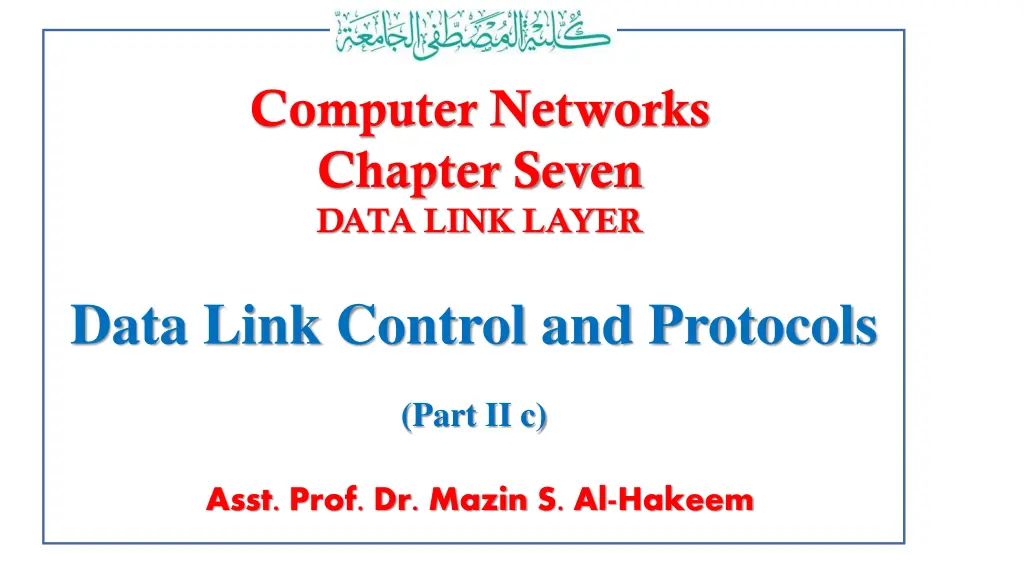
Data Link Control and Protocols in Computer Networks Chapter 7
Explore the Go-Back-N ARQ Protocol for efficient data transmission, featuring sequence numbers, sender sliding window concepts, and frame management. Understand the division of sequence numbers into regions within the sender's sliding window for effective frame handling.
Download Presentation

Please find below an Image/Link to download the presentation.
The content on the website is provided AS IS for your information and personal use only. It may not be sold, licensed, or shared on other websites without obtaining consent from the author. If you encounter any issues during the download, it is possible that the publisher has removed the file from their server.
You are allowed to download the files provided on this website for personal or commercial use, subject to the condition that they are used lawfully. All files are the property of their respective owners.
The content on the website is provided AS IS for your information and personal use only. It may not be sold, licensed, or shared on other websites without obtaining consent from the author.
E N D
Presentation Transcript
Computer Networks Chapter Seven DATA LINK LAYER Data Link Control and Protocols (Part II c) Asst. Prof. Dr. Mazin S. Al-Hakeem
7.6- Protocols 7.6.2- Noisy (error-creating) Channels B. Go-Back-N ARQ Protocol To improve the efficiency of transmission, multiple frames must be in transition while waiting for acknowledgment. In other words, we need to let more than one frame be outstanding to keep the channel busy while the sender is waiting for acknowledgment. With Go-Back-N ARQ we can send several frames before receiving acknowledgments; we keep a copy of these frames until the acknowledgments arrive.
Sequence Numbers (seqNo & ackNo) m In the Go-Back-N Protocol, the sequence numbers are modulo-2 , where m is the size of the sequence number field in bits allocated in the frame header. For example, if m is 4, the only sequence numbers are 0 through 15 inclusive. However, we can repeat the sequence. So the sequence numbers are: 0, 1,2,3,4,5,6, 7,8,9, 10, 11, 12, 13, 14, 15,0, 1,2,3,4,5,6,7,8,9,10, 11, ...
Sender Sliding Window At the sender side, to hold the outstanding frames until they are acknowledged, we use the concept of window. We imagine that all frames are stored in a buffer. The outstanding frames are enclosed in a window. The maximum size of the window is (2 1). m The sliding window of size 15 i.e is (m =4), the size of the sliding window is 14.
Sender Sliding Window The window at any time divides the possible sequence numbers into four regions. The first region, from the left of the window, defines the sequence numbers belonging to frames that are already acknowledged. The sender does not worry about these frames and keeps no copies of them. The second region, defines the range of sequence numbers belonging to the frames that are sent and have an unknown status. The sender needs to wait to find out if these frames have been received or were lost. We call these outstanding frames. The third region, defines the range of sequence numbers for frames that can be sent; however, the corresponding data packets have not yet been received from the network layer. Finally, the fourth region defines sequence numbers that cannot be used until the window slides.
Sender Sliding Window m The send window is an abstract concept defining an imaginary box of size 2 1 with three variables: Sf, Sn and Ssize. The variable Sf defines the sequence number of the first (oldest) outstanding frame. The variable Sn holds the sequence number that will be assigned to the next frame to be sent. Finally, the variable Ssize defines the size of the window, which is fixed in our protocol.
Sender Sliding Window This figure shows how a send window can slide one or more slots to the right when an acknowledgment arrives from the other end. Frames 0, 1, and 2 are acknowledged, so the window has slid to the right three slots. Note that the value of Sf is 3 because frame 3 is now the first outstanding frame.
Receiver Sliding Window The receive window makes sure that the correct data frames are received and that the correct acknowledgments are sent. The size of the receive window is always 1. The receiver is always looking for the arrival of a specific frame. Any frame arriving out of order is discarded and needs to be resent.
Receiver Sliding Window Note that we need only one variable Rn (receive window, next frame expected) to define this. The sequence numbers to the left of the window belong to the frames already received and acknowledged; numbers to the right of this window define the frames that cannot be received. the sequence Any received frame with a sequence number in these two regions is discarded; only a frame with a sequence number matching the value of Rn is accepted and acknowledged. The receive window also slides, but only one slot at a time. When a correct frame is received, the window slides.
Acknowledgment Note The receiver sends a positive acknowledgment if a frame has arrived safe and sound and in order. If a frame is damaged or is received out of order, the receiver is silent and will discard all subsequent frames until it receives the one it is expecting. The silence of the receiver causes the timer of the unacknowledged frame at the sender site to expire. This, in turn, causes the sender to go back and resend all frames, beginning with the one with the expired timer. The receiver does not have to acknowledge each frame received. It can send one cumulative acknowledgment for several frames.
Resending a Frame When the timer expires, the sender resends all outstanding frames. For example, suppose the sender has already sent frame 6, but the timer for frame 3 expires. This means that frame 3 has not been acknowledged; the sender goes back and sends frames 3, 4, 5, and 6 again. That is why the protocol is called Go-Back-N ARQ.
Resending a Frame Operation As we can see, multiple frames can be in transit in the forward direction, and acknowledgments in the reverse direction. multiple The idea is similar to Stop-and- Wait ARQ; the difference is that the send window allows us to have as many frames in transition as there are slots in the send window.
EXAMPLE (2) This is an example of a case where the forward channel is reliable, but the reverse is not. No data frames are lost, but some ACKs are delayed and one is lost. m = 3 Ssize = 6 0, 1, 2, 3, 4, 5, 6, 7, 0, 1, 2, 3, 4, The example also shows how cumulativeacknowledgments can help if acknowledgments are delayed or lost.
EXAMPLE (2) After initialization, there are seven sender events. Request events are triggered by data from the network layer; arrival events are triggered by acknowledgments from the physical layer. There is no time-out event here because all outstanding frames are acknowledged before the timer expires. Note that although ACK2 is lost, ACK3 serves as both ACK2 and ACK3. There are four receiver events, all triggered by the arrival of frames from the physical layer.
EXAMPLE (3) This example shows what happens when a frame is lost. Frames 0, 1, 2, and 3 are sent. However, frame 1 is lost.
EXAMPLE (3) The receiver receives frames 2 and 3, but they are discarded because they are received out of order (frame 1 is expected). The sender receives no acknowledgment about frames 1, 2, or 3. Its timer finally expires.
EXAMPLE (3) The sender sends all outstanding frames (1, 2, and 3) because it does not know what is wrong. Note that the resending of frames l, 2, and 3 is the response to one single event. When the sender is responding to this event, it cannot accept the triggering of other events. This means that when ACK 2 arrives, the sender is still busy with ending frame 3.
EXAMPLE (3) The physica1layer must wait until this event is completed and the data link layer goes back to its sleeping state. We have shown a vertical line to indicate the delay. I t is the same story with ACK 3; but when ACK 3 arrives, the sender is busy responding to ACK 2. It happens again when ACK 4 arrives. Note that before the second timer expires, all outstanding frames have been sent and the timer is stopped.
Go-Back-N ARQ simplifies the process at the receiver site. The receiver keeps track of only one variable, and there is no need to buffer out-of-order frames; they are simply discarded. However, this protocol is very inefficient for a noisy link. In a noisy link a frame has a higher probability of damage, which means the resending of multiple frames. This resending uses up the bandwidth and slows down the transmission. For noisy links, we need for another mechanism that does not resend N frames when just one frame is damaged; only the damaged frame is resent.
Computer Networks Chapter Seven DATA LINK LAYER Data Link Control and Protocols (Part II c) Asst. Prof. Dr. Mazin S. Al-Hakeem



